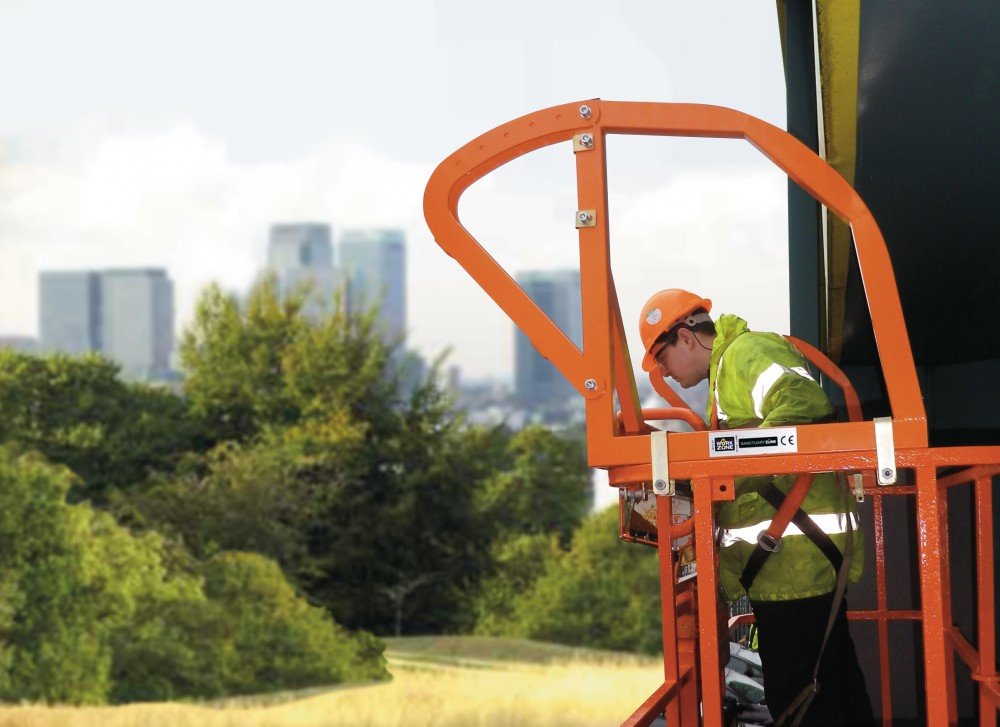Height safety: tips for MEWP users
Working at height poses many risks. Brian Parker offers some advice on how to minimise the risk of an accident when using a mobile elevating work platform (MEWP).

Secondary guarding devices, such as SanctuaryZone (pictured) can help to prevent operators being crushed between the machine and an overhead obstruction
Once you have identified work that involves placing people at height, the next step is to plan carefully to ensure the safety of the machine operator and anyone working nearby on the ground.
Following the hierarchy of the work at height regulations, and having decided that a MEWP is the most suitable and appropriate equipment to use to minimise the risk of a fall, it is important that you conduct a site survey to determine the type of MEWP required.
This should take into account the height and location of the work involved – in other words, how are you going to reach it? You need to consider if there are any access and egress issues – for example, are there any underground or overhead hazards, weight restrictions, safe working load issues? These aspects need to be factored in when looking at the MEWP’s dimensions. If the task involves working indoors, then emissions and noise need to be considered and an electric machine would be ideal. If the project is outdoors, then machines with rough terrain capability may be more suitable, but don’t forget to take into account wind forces.
Training
After you have carried out a work at height assessment and ascertained which employees will need to use the MEWP, then operator and manager training are essential.
MEWP operators traditionally complete a 1-3 day IPAF operator course, which is held at approved IPAF training centres. Anyone who supervises and plans for people to work at height in MEWPs must also be trained and be competent. The one-day IPAF MEWPs for managers course addresses this and the need for supervising and planning all MEWP operations.

Powered access machines in action
Machine pre-use checks and onsite familiarisation
To ensure the MEWP is working correctly, an operator should carry out a daily pre-use inspection and record it. The inspection should include a full function test of both the lower and upper controls and any emergency lowering devices. Any faults found should be reported immediately. This may mean isolating and tagging the MEWP to warn others.
Awareness of overhead obstructions and other site hazards
When working at height, overhead obstructions must be considered. In the blink of an eye, an overhead beam, lighting bracket or other object could become a serious danger. Many operators, although familiar with MEWPs, fail to understand the dynamics of their machine and how quickly the platform basket may lift or lower from driving over or off an obstacle when the platform is in the raised position. Therefore, any risk assessment should also consider the possibility of entrapment or collision with external sources, and secondary guarding may need to be fitted to the machine.
Secondary guarding and contractor control and isolation devices
Secondary guarding devices have become a very important addition to powered access machines because they can help to prevent operators being crushed between the machine and an overhead obstruction.
However, it is essential that operators do not rely solely on these devices – rather than being lulled into a false sense of security, they must take full responsibility for their own safety and be aware of all potential hazards around them.
A secondary guarding device has been described as “a piece of equipment which is either intended to reduce the risk of entrapment and/or provides an alert that an entrapment situation has occurred”.
MEWP isolation and authorisation devices can now be fitted to MEWPs to fully control their use. These have the advantage of only allowing authorised users to operate them.
Work platform rescue procedures
Failure to plan means prepare to fail. Why would a work platform not lower? Examples include platform malfunction or overload, the operator becoming ill, being injured or trapped, or being caught or snagged on a structure.
A rescue plan should identify suitably trained, site-based people who would be available to lower the work platform, using the machine’s ground controls or emergency lowering system.
Brian Parker is business development manager, technical support at AFI.
Height safety: tips for MEWP users
Working at height poses many risks. Brian Parker offers some advice on how to minimise the risk of an accident
Safety & Health Practitioner
SHP - Health and Safety News, Legislation, PPE, CPD and Resources Related Topics
Gogglebox star George Gilbey died after fall through skylight
Inclusivity in PPE: The manufacturer’s perspective
Future-proofing safety: Five trends shaping the PPE landscape of tomorrow



Great post! I’m sure construction workers would find very helpful information from this blog.
[…] https://www.shponline.co.uk/height-safety-tips-mewp-users/ […]